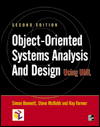 Object-Oriented Systems Analysis and Design Using UML, 2/e Simon Bennett,
Systems Architect with GEHE UK
Steve McRobb,
Senior Lecturer, De Montfort University
Ray Farmer,
Associate Dean, Coventry University
OverviewISBN: 0077098641
No of pages: 612 pages
Published: December 2001 Object-Oriented Systems Analysis and Design using UML
introduces students to the overall process of systems analysis and design. We
also discuss implementation issues in useful detail and give code fragments
to show possible mappings to implementation technology. It also addresses transferable
skills, such as those used in fact-finding and project management.
The book presents various lifecycle models, and provides a framework for development
using an iterative and incremental process and the major techniques from UML
1.4. Two case studies are used, one for illustrative examples and the other
for practical exercises for the reader.
The book is structured into four sections, which can be combined in different
ways to be of relevance for different modules. The first section is an introduction
to information systems and provides the context; the second section explains
fundamental object-oriented concepts and covers requirements capture and analysis;
the third covers system design and object design; and the fourth covers system
development management and methodologies.
The book provides a clear and comprehensive treatment of UML 1.4 in the context
of the systems development life cycle, without assuming previous knowledge of
analysis and design.
Extensive use of examples and exercises from the two case studies provides the
reader with many opportunities to practise the application of UML.
Written as a course book for students who are first encountering systems analysis
and design at whatever level, the book will also be found useful for professionals
wishing to update their skills in modern object-oriented methods.
The first edition has been adopted as a set text on courses worldwide. The second
edition updates the notation to follow the latest version of the UML standard
and reflects the most up to date approaches to the information systems development
process.
|
|




 2002 A McGraw-Hill Online Learning Centre
2002 A McGraw-Hill Online Learning Centre